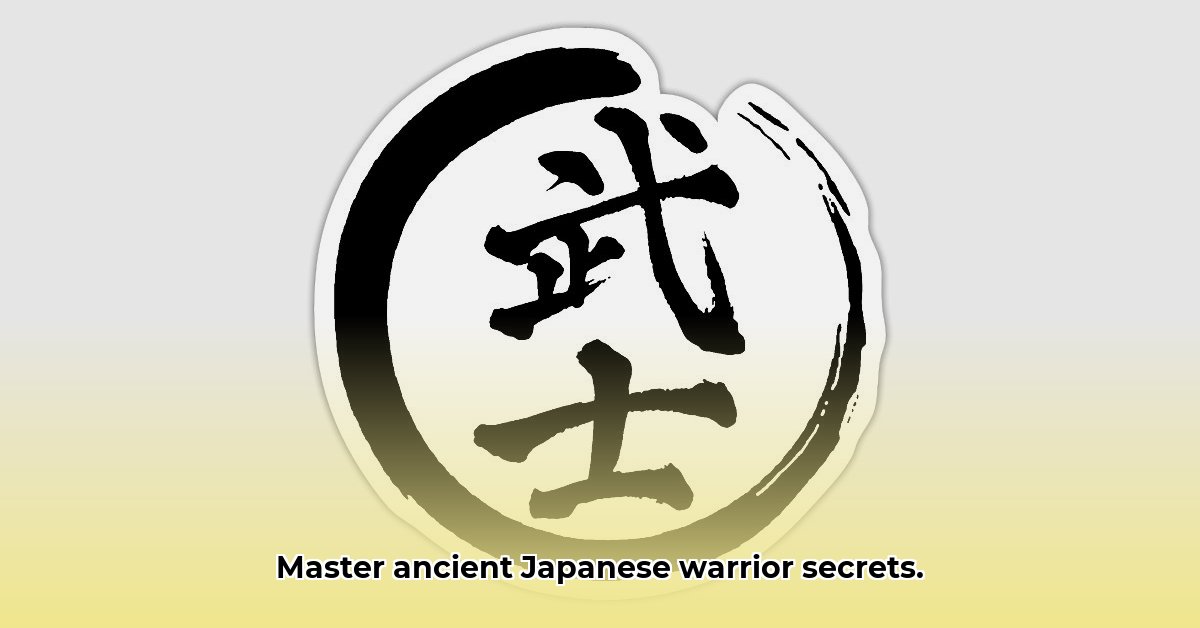“`markdown
Decoding Japanese Warrior Terms: A Comprehensive Guide
Have you ever been captivated by anime or immersed in a video game, only to be confused by the various Japanese warrior terms? This guide serves as your key to unlocking the intricacies of words like samurai, bushi, and more. Delve into their meanings, appropriate usage, and common pitfalls, and equip yourself with the knowledge to navigate the world of Japanese warrior terminology with confidence!
Exploring the Nuances of Japanese Warrior Terminology
Venture into the multifaceted world of Japanese warrior terms, where each word echoes the weight of history. This exploration goes beyond mere translation, offering a deep dive into the history, social structures, and cultural evolution that shaped these terms.
Samurai (侍): Beyond the Sword, Embracing Service
The term “samurai” (侍) likely conjures images of skilled swordsmen. Intriguingly, the kanji itself translates to “to serve,” highlighting a core aspect of the samurai’s role. Samurai were retainers serving powerful feudal lords, the daimyo, and belonged to a distinct social class governed by the Bushido code – the way of the warrior. Bushido stressed the virtues of honor, loyalty, and martial prowess, granting samurai significant influence and prestige. The social status and power wielded by the samurai class underwent several transformations throughout Japanese history.
Bushi (武士): A Broader View of the Military Landscape
“Bushi” (武士), directly translating to “military person,” provides a more encompassing term for warriors. Envision “bushi” as the overarching category encompassing a variety of warriors. Throughout Japanese history, many warriors were considered “bushi” without necessarily holding the elite status of “samurai.” This included lower-ranking soldiers, mercenaries, and members of rural militias. The term bushi underscores the diversity within the Japanese military landscape.
Buke (武家): The Warrior Class as a Collective Entity
Shifting the focus from individual warriors, “Buke” (武家) refers to the entire warrior class. This term encompasses the families, clans, and lineages that possessed military power and wielded social influence. The emphasis moves from the individual warrior to the broader social and political structures they represented. “Buke” reflects the established institutions and hereditary nature associated with Japan’s warrior society.
Senshi (戦士): A Universal Designation for Warriors
“Senshi” (戦士) offers the most general and universally applicable term for “warrior.” This straightforward term applies to any soldier or fighter, irrespective of social standing or historical era. Devoid of the historical context and social class implications inherent in more nuanced terms, “senshi” serves as a neutral, all-encompassing designation. The widespread usage of “senshi” reflects a more egalitarian perspective on warriors, transcending social hierarchies.
Shi (士): Blending the Lines Between Warrior and Scholar
“Shi” (士) blurs the boundaries between the archetypes of the warrior and the scholar. While “shi” can refer to a warrior, it more commonly signifies a man of refined character, integrity, and scholarly pursuits. Encompassing virtues and intellectual endeavors, “shi” challenges the notion that martial prowess alone defines a person’s worth or status as a warrior. It emphasizes the cultivation of both physical and intellectual capabilities.
Addressing Common Misconceptions in Anime and Video Games: Striving for Accurate Portrayals
Anime and video games frequently employ these terms, but often fall prey to oversimplification and misuse. A prevalent error is labeling every warrior encountered in a historical setting as a “samurai,” overlooking the nuances of social rank and military organization. Accurate and informed usage significantly bolsters historical authenticity and demonstrates a deeper understanding of Japanese culture.
Context as the Cornerstone: Selecting the Appropriate Term
Choosing the correct term hinges critically on historical and social context. A common foot soldier from the medieval period would more appropriately be designated a “bushi,” not a “samurai.” Achieving this level of accuracy is paramount for effectively portraying Japanese history and culture with integrity.
Unveiling Kanji Components: A Gateway to Deeper Understanding
Examining the individual kanji (Chinese characters) that constitute each word reveals layers of deeper meaning. The kanji comprising “bushi,” for instance, directly relate to military matters and the skills associated with warfare. Understanding the etymology, origin, and evolution of these nuanced terms fosters a richer appreciation for their significance and historical context.
Deciphering Japanese Warrior Terminology: Bushi, Samurai, and Senshi
Let’s delve into the distinctions between the Japanese warrior terms bushi, samurai, and senshi, unraveling the complexities that separate them. These words, frequently used interchangeably in modern contexts, possessed remarkably distinct meanings within the hierarchical structure of feudal Japan.
Samurai: The Elite Warrior Social Class
Samurai (侍) represented the elite, a hereditary class of warriors directly serving powerful feudal lords, the daimyo. This privileged status came with both responsibilities and rights. Governed by the strictures of the Bushido code, emphasizing honor, loyalty, and martial prowess, samurai were readily identified by their katana, the iconic curved sword. While all samurai were, by definition, warriors, it is important to understand the specific social and ethical implications of the term.
Bushi: The Broader Social Term
Bushi (武士) translates directly to “warrior,” but served as a significantly broader umbrella category. It encompassed not only the elite samurai, but also foot soldiers (ashigaru), masterless samurai (ronin), and even warrior monks (sohei). Crucially, bushi did not necessarily imply hereditary privilege, adherence to the Bushido code, or the same level of social prestige as the samurai.
Senshi: A Modern Designations Bridging Historical Divides
Senshi (戦士) has emerged as a modern, more generalized term simply meaning “warrior,” lacking the specific historical baggage and social class connotations of bushi and samurai. Frequently encountered in modern media such as anime and video games, it is sometimes used interchangeably with the other terms – a simplification that often sacrifices historical accuracy for broader audience appeal.
Shi: Warrior and Scholar Combination
While less frequently encountered than the other terms, shi (士) represents a broader grouping that embodied both martial and intellectual capabilities, blurring the lines between purely military roles and administrative or scholarly functions. Its specific usage is less straightforward than that of bushi or samurai and often implies a degree of learnedness and strategic thinking beyond mere combat skills.
Understanding Kanji Components for Deeper Japanese Term Meanings
A deeper understanding of these terms can be achieved by delving into the meaning of the kanji characters used to write them. For example, the samurai kanji includes a character relating to “to serve,” reminding us that service to a lord was an essential part of the samurai identity.
Avoiding Misuse in Media: Accurately Representing Social Rank
Anime and video games often carelessly interchange these terms, leading to historical inaccuracies and perpetuating misunderstandings about feudal Japanese society. A common example is portraying a low-ranking foot soldier as a “samurai,” which not only misrepresents social hierarchies but also diminishes the specific responsibilities and privileges associated with that elite class.
Key Differentiations Elements:
- Samurai: Elite hereditary warrior class, bound by Bushido, primarily known for wielding katanas and serving their lords.
- Bushi: Broad term for any warrior, including samurai, but not limited to them. A more general military designation.
- Senshi: Modern term for warrior, lacks the specific historical connotations and social class implications of the other terms.
- Shi: Denotes a class with both military and intellectual acumen, often involved in administrative or scholarly roles.
- Accurate representation: Accurate use in historical contexts avoids perpetuating misconceptions and enriches the understanding of Japanese society.
Analyzing the Evolution of Japanese Warrior Terminology Across Historical Periods
Key Takeaways:
- The romanticized samurai image often overshadows the evolution of military tactics and the diverse roles of other warrior classes.
- Japanese warrior terminology provides valuable insights into evolving military tactics, social structures, and political power dynamics.
- Careful analysis of historical sources is essential for a more nuanced understanding of warrior roles and terminology.
- Understanding kanji components unlocks deeper layers of meaning and historical context.
- Modern media often misrepresents these terms, requiring critical analysis and a discerning approach.
From Tsuwamono to Samurai: Charting the Shifting Landscape of Warrior Nomenclature
Explore the dynamic evolution of warrior terminology through Japanese history. Prior to the ascendance of the samurai as the dominant warrior class, earlier terms such as tsuwamono and musha denoted professional fighters and reflected the growing influence of private military power.
Deconstructing the Terminology: Examining Roles and Social Class
The term bushi, signifying a specific social and military role, underwent significant evolution over time. Then comes the rise of the buke, solidifying the warrior class as a powerful force in Japanese society. What are the subtle differences and connections between these related terms? Further complicating matters, the word senshi also appears; how does it relate to the others, and what does its emergence signify? Finally, consider shi, often signifying a knightly class or a man of high moral character.
Understanding the Kanji: Unlocking Japanese History
Many Japanese terms for warriors are imbued with layers of meaning and historical context which are revealed through their kanji, the ideographic characters used in writing. What additional insights and historical connections can we uncover through a careful examination of these
- Unlock Ancient Roman Jewelry’s Secrets: History, Materials, & Symbolism Revealed - August 14, 2025
- Unveiling Ancient Roman Mythical Creatures: Legends, Powers & Origins Defined for Today’s Enthusiast - August 14, 2025
- Unlock Ancient Secrets: Ancient Roman Attire Women, Status, & Materials [Guide] - August 14, 2025
















